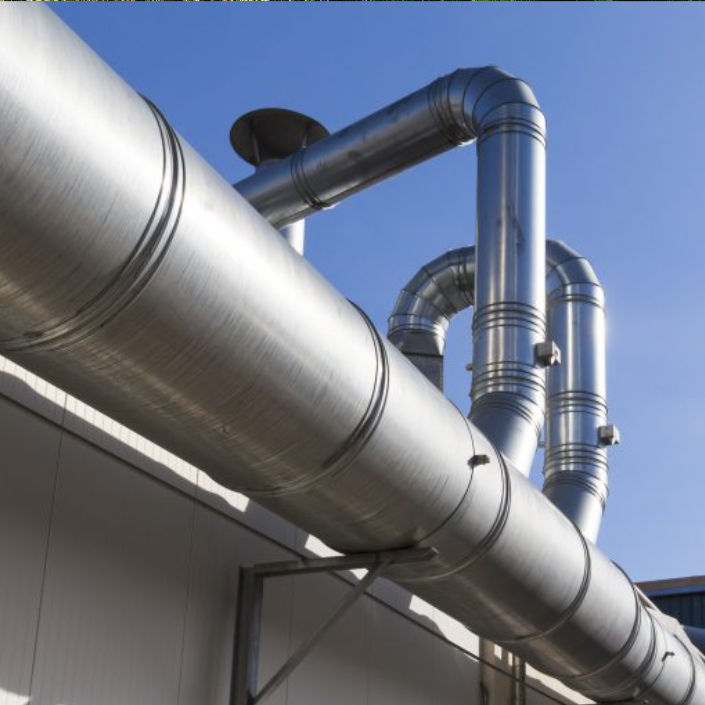BIO-TRICKLING
Biotrickling is a biological air treatment method such as biofilter and bio-scrubbing. Beside the differences in the apparatus design, the mechanism of the air treatment process is similar.
Similar to bio-scrubbers because gas contaminants are absorbed in a free liquid phase prior to biodegradation by either suspended or immobilized microorganisms and to biofilters because the degradation of gas contaminants is a result of biological activity of microorganisms fixed on supporting elements.
In a biological trickle bed reactor, an aqueous phase is continuously circulated through a bed of inert (natural or synthetic) material. This packing can consist of irregular bulk material, such as plastic rings, ceramic elements or lava rocks. Filling bed can be realized by means of structured or by bulk materials (e.g., lava rocks); in both cases, it is critically important that the biofilm adheres firmly on the surface of the bed’s filling material. The pollutants in the waste gas and the oxygen are absorbed by the water phase and transported to the biofilm, where the biological transformation takes place.
The immobilization of the biomass and the formation of the biofilm are generally a naturally controlled process which starts after inoculation of the water phase. The quality of the mass transfer from the gas to the liquid phase and the elimination performance of the reactor depend essentially on the wetted surface area of the packing. Therefore, in order to maximize the wetted surface area, the liquid phase should be distributed uniformly over the surface of the biofilm. The continuously circulating liquid phase takes on the function of supplying the microbe population with the necessary nutrients. At the same time, excess activated sludge and reaction products which can also be inhibitors are washed out of the reactor. In the liquid phase, the essential conditions such as pH, nutrients and salt accumulation need to be controlled. The stream of treated (cleaned) air leaves the biofilter together with formation of CO2, H2O and biomass as biodegradation products.
Vessel can be realized in several materials, such as AISI 304, AISI 316, PP (polypropylene), galvanized steel.
Biotrickling filters operate with the air and water phases moving either counter-currently or co-currently, depending on the specific operation.
Our team of A&L Engineering will support you at the aim of obtaining the best air treatment system you need.
ADVANTAGES
Bio-Trickling is a good compromise between footprint and pollutants removal efficiency.
BOUNDARY CONDITIONS / DESIGN PARAMETERS
- Temperature: 15-40 °C, optimum 30-35°C
- VOCs concentration in waste gas: 400-2,000 mg/Nm3
- NH3 concentration in waste gas: 100-400 mg/Nm3
- Odour: < 20,000 uo/ Nm3
- Hydrogen sulphide concentration in waste gas: 50-200 mg/Nm3
- Mercaptan concentration in waste gas: 5-100 mg/Nm3
- Air flow characteristics must be as constant as possible (i.e., in terms of chemical-physical characteristics)
Please, consider that data aforementioned do not constitute technical information and are mentioned by way of example.
APPLICATIONS AND PERFORMANCES
Bio-Trickling is used in biological decomposition of components that produce odours as well as a wide range of VOCs. In the following table are reported the compounds group on which the Bio-Trickling is effective
(Source: Best Available Techniques (BAT) Reference Document for Common Waste Water and Waste Gas Treatment/Management Systems in the Chemical Sector, 2016).
| Well suited | Basically suited | Not suited |
|---|---|---|
| – Alcohols (methanol, ethanol, butanol, glycol, di-glycol, butyl glycol) – Aldehydes and ketones (formaldehyde, acetaldehyde, ace-tone, MIBK) – Carboxylic acids and their esters (acetic acid, propionic acid, butyric acid, n-butyl acetate, ethyl acetate, methyl methacrylate, glycolic acid ester) – Phenols (phenol, cresol) Mercaptans Amines Ammonia Heterocyclic, 1,2-dichlo-roethane, chlorophenols Hydrogen sulphide | Styrene, naphthalene Heterocyclic Sulphur compounds Carbon di-sulphide Trichloroethene, VCM | Aliphatic hydrocarbons (methane, pentane) Per-chloroethene, 1,1,1-trichloroethane |
Please, consider that data shown in table do not constitute technical information and are mentioned by way of example
ENVIRONMENTAL FEATURES
Exhaust recirculation solution must be treated within the plant (if possible) where Bio-Trickling is operating or disposed of.
ENERGY CONSUMPTION
Energy consumption depends on fans power (that are chosen according to the site conditions: e.g., ducts length and diameter) and on the number and power of recirculation pumps installed.
RELATED PRODUCTS
- Nutrient solution
- microorganisms
- filling materials
AUXILIARY PRODUCTS
- water (for reintegration of losses due to air flow saturation and to exhaust water)
- chemical/microbial products
- electro-mechanical equipment.


 @airqualitymaker.com
@airqualitymaker.com @airqualitymaker.com
@airqualitymaker.com